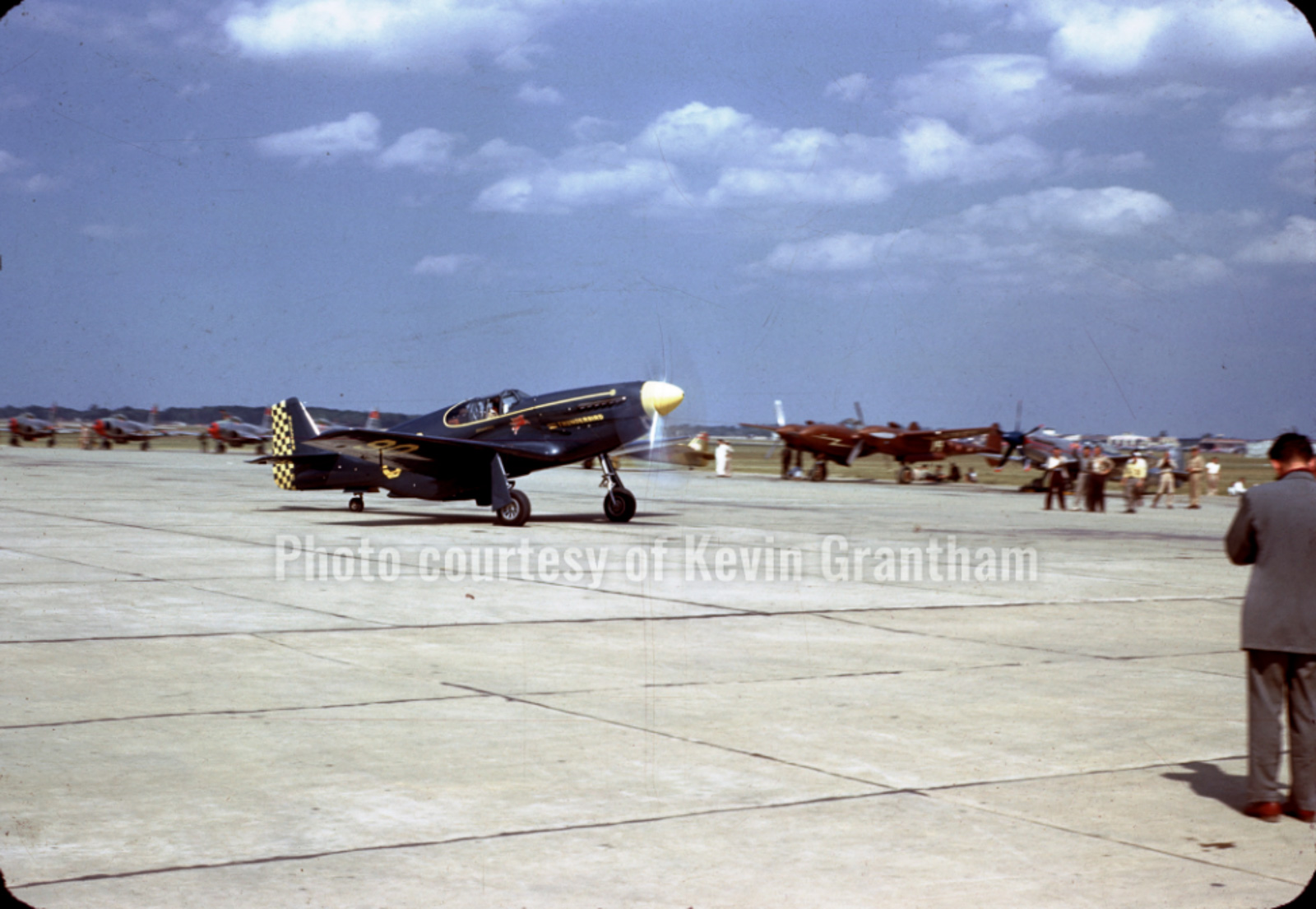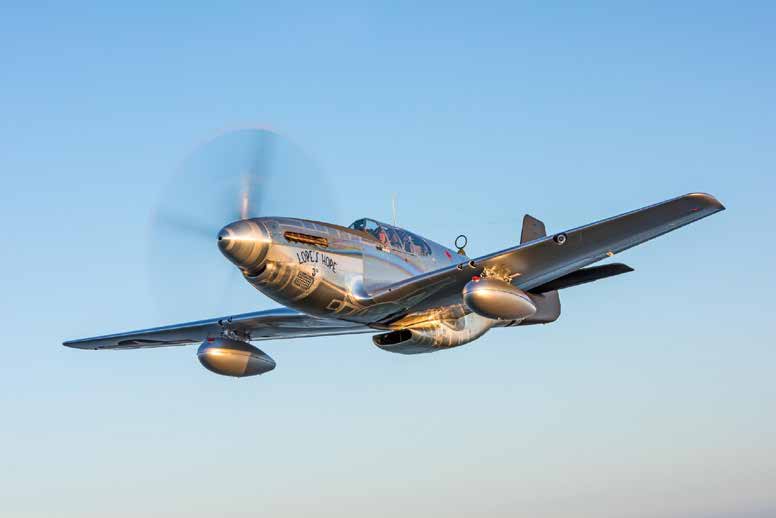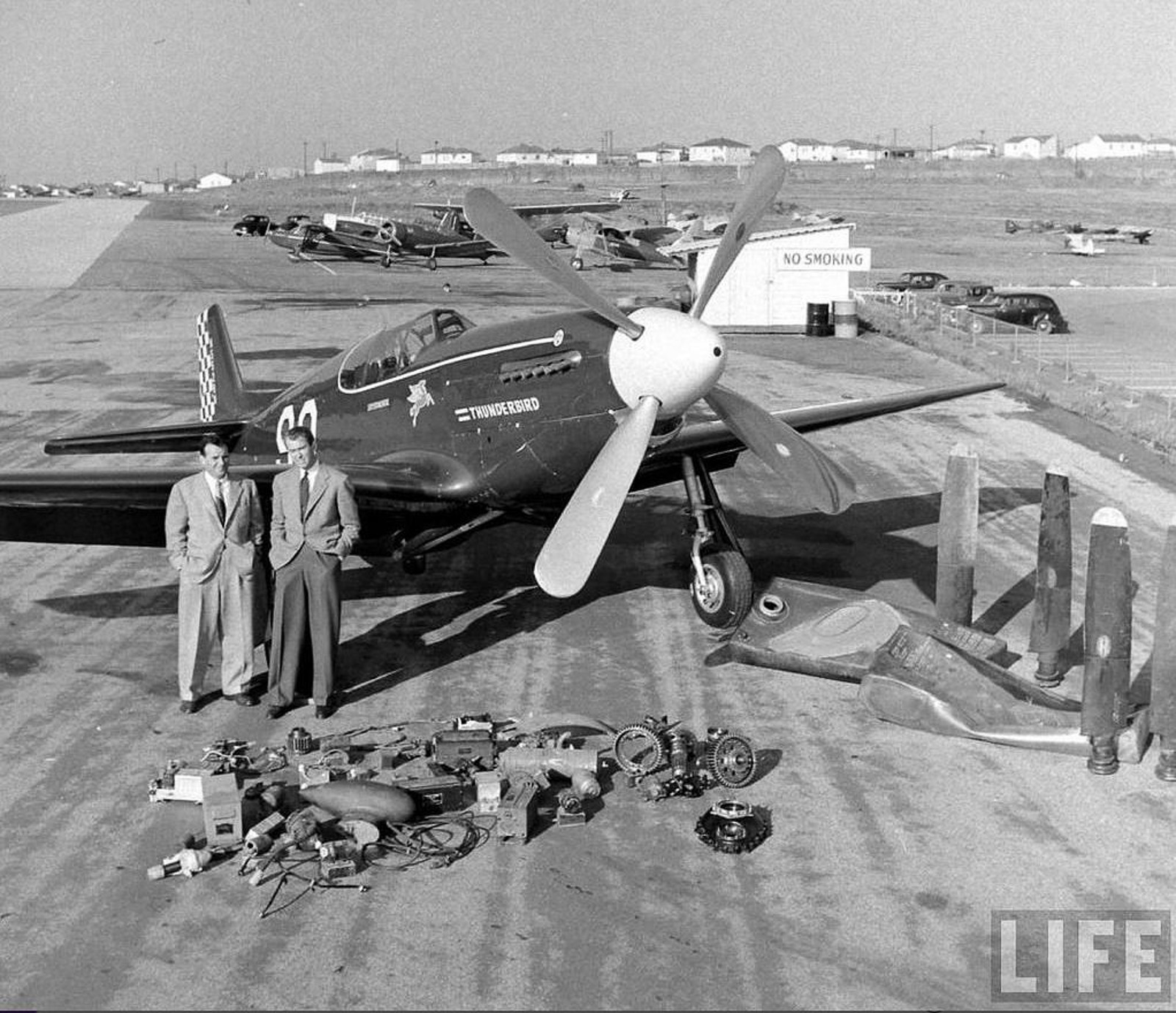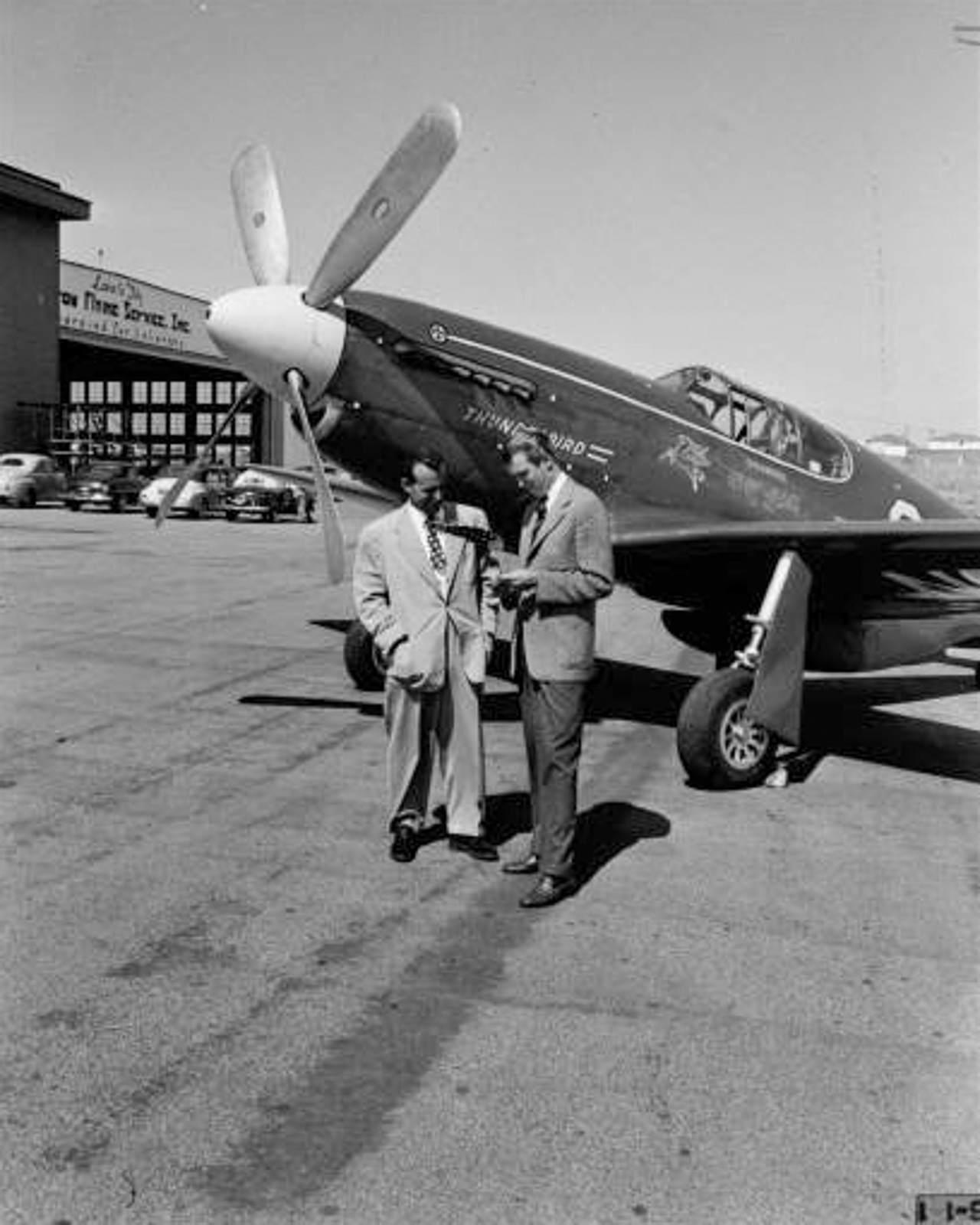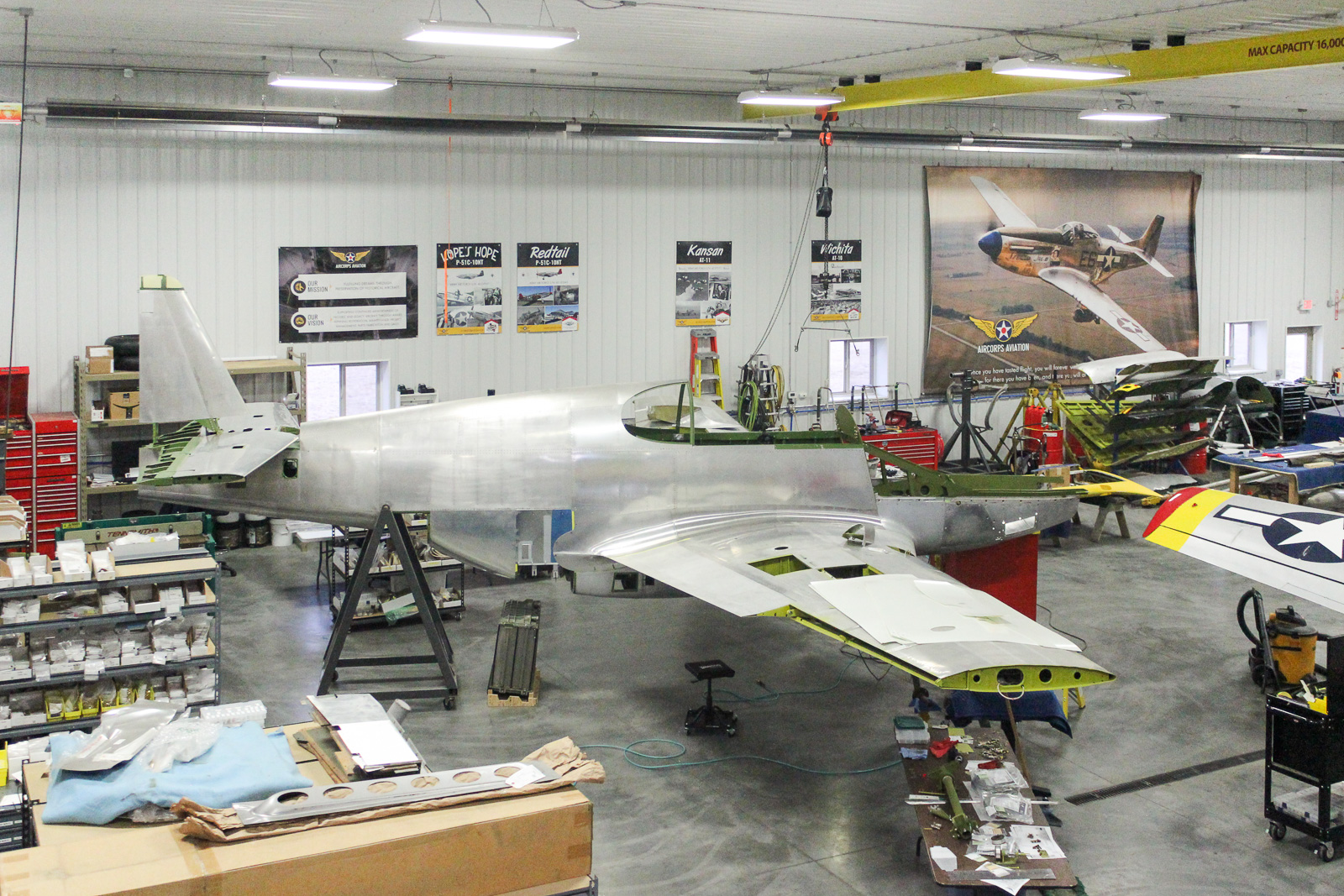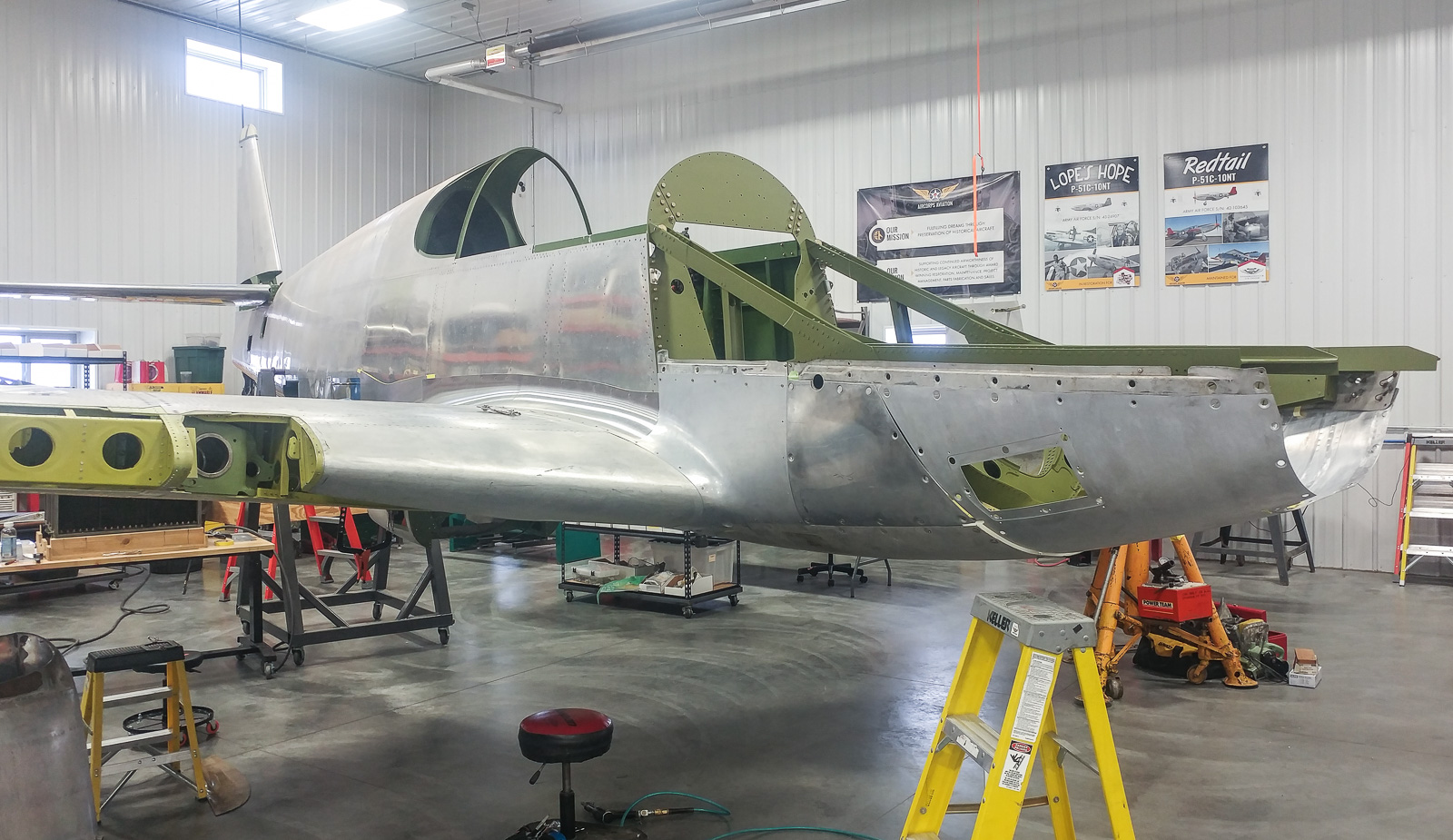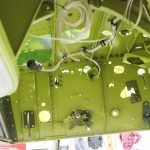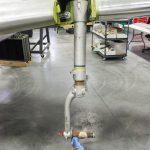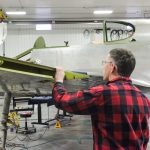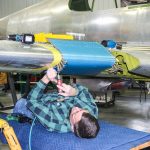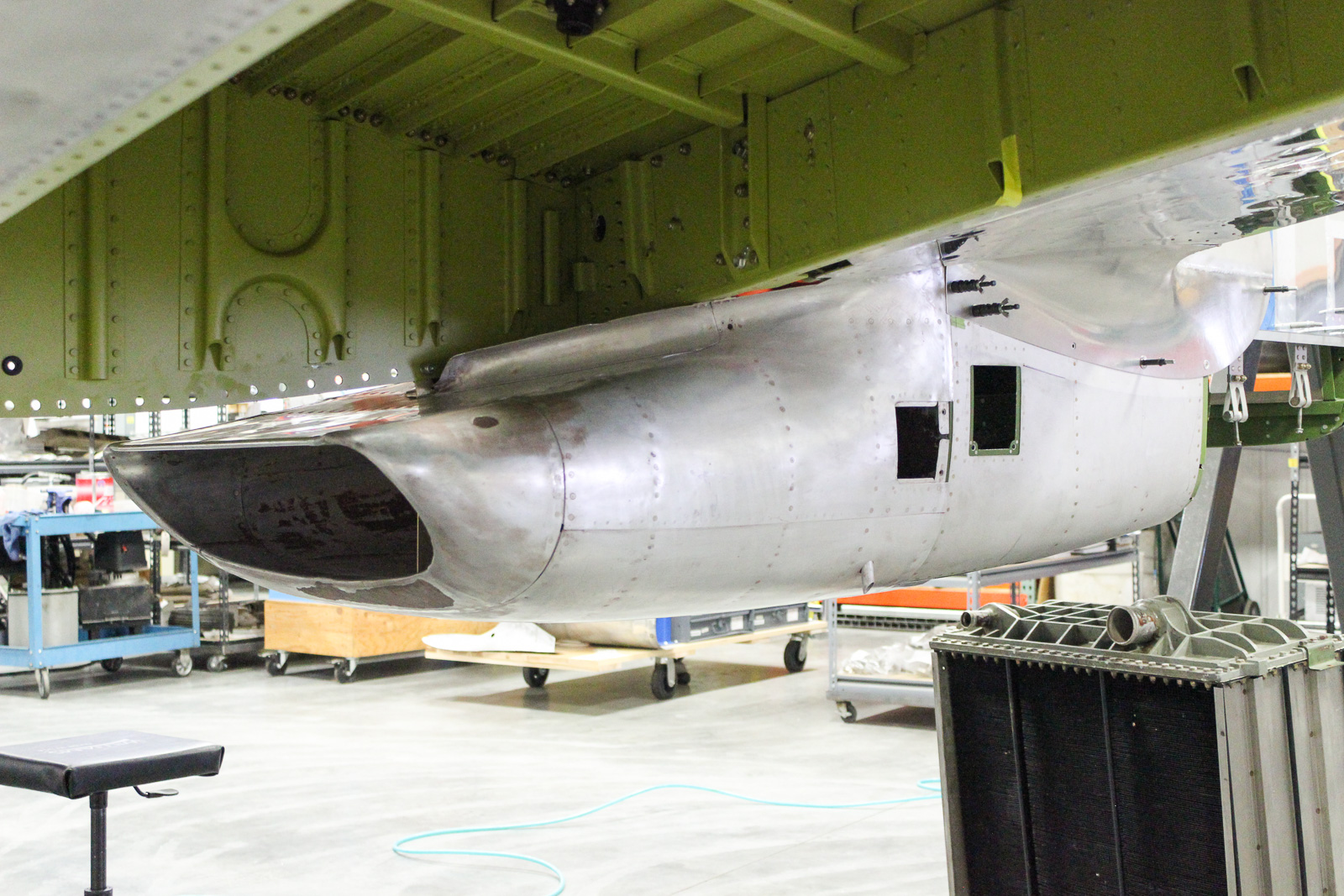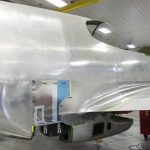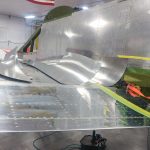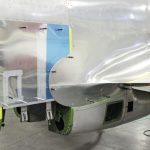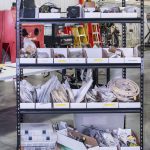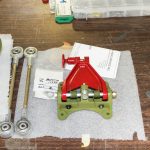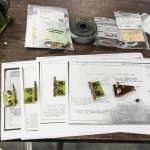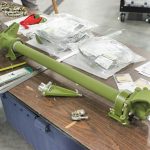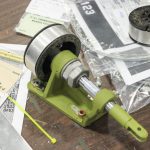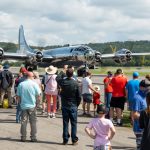Over the past several years, aviation historian Chuck Cravens has brought us regular updates regarding ongoing restoration projects at AirCorps Aviation in Bemidji, Minnesota. Many of the aircraft involved have been for Warren Pietsch’s fabulous Dakota Territory Air Museum, and such is the case for this particular story about the resurrection of a long-lost legendary racing Mustang which dates to the post-war Cleveland National Air Races. It’s now time to sit back and enjoy this remarkable story…
Record Setting Bendix Trophy Winner
Dakota Territory Air Museum’s P-51C Mustang Thunderbird
by Chuck Cravens
A ten year old boy paints a picture of a P-51 Mustang on his bedroom wall and dreams that he is in the cockpit, swooping through a cathedral of clouds at 400mph. Everyone intrigued with warbirds likely shared in this same fantasy at some point during childhood, but for most, flying a Mustang will always elude us. But this story concerns more than wistful aspirations, it is about how that same 10 year old boy made his dream a reality. Looking up at his wall, a young Warren Pietsch vowed that someday he would own and fly a P-51… but he couldn’t do it alone.
Warren’s father, Al Pietsch, owned Pietsch Flying Service in Minot, North Dakota, and Warren was fortunate to grow up in the family aviation business. In the 1990’s Warren took ownership of the company and renamed it Pietsch Aircraft Restoration & Repair, Inc. which would eventually become Minot Aero Center. Warren’s father, his mother Eleanor, and brothers Gary and Kent, were all pilots and supported Warren’s flying career early on. Many others were also encouraging: Gary Johnson, a mechanic and pilot who began working for Warren’s dad in 1964 and now works for Warren; Don Larson, chairman of the Dakota Territory Air Museum; close friends Brian Sturm, Jay Blessum, and many others, played roles in Warren’s aviation story.
Over the years, as his experience and pilot qualifications expanded, Warren had the chance to fly warbirds, like the Mustang, with the Dakota Territory Air Museum and Texas Flying Legends. These opportunities arose because people in the warbird industry like Casey Odegaard, Bernie Vasquez, Doug Rozendaal, Dusty Dowd, and Forest Lovely all provided friendship, knowledge, encouragement, and/or training. Warren couldn’t have ventured down this path with Thunderbird without fellow dreamers like Gerry Beck and Bob Odegaard – it takes an industry to bring these aircraft back to life.
In 1999, Warren purchased what he believed to be a damaged P-51A in Scottsbluff, Nebraska. It was only later that he discovered that what he’d actually acquired were the mortal remains of Thunderbird, the iconic blue P-51C which Jimmy Stewart once flew in the Bendix Air Races just after WWII. This discovery, and the incredible history of this specific Mustang, began Warren’s journey to restore Thunderbird as a tribute to its legendary owners. Jimmy Stewart, Joe DeBona, Jackie Cochran, and Jim Cook. Thunderbird is truly a people’s airplane because of the many folks involved with the dream since the beginning, and those tasked with breathing life into the project.
For every warbird, the question of “why this particular airplane?” comes up. Once Warren learned that his Nebraskan purchase was Jimmy Stewart’s Thunderbird, this news alone was enough to inspire a tribute restoration. The modified P-51C’s history is ripe with accomplishments from air racing, to coronation tapes and speed records. In addition to Jimmy Stewart, Thunderbird’s story also includes household names from aviation and popular culture alike, names such as Jackie Cochran, Joe DeBona, and even Queen Elizabeth II.
Once completed, Thunderbird will look and feel very different to any presently airworthy, military-schemed Mustangs. She isn’t meant to be a “time capsule” aircraft with every detail and rivet precisely faithful to the original. Instead, the Thunderbird of today will honor its predecessor by retelling the Thunderbird story, and showing the public what the iconic aircraft looked like when she took part in the air races of yore.
The retelling of further aspects of Thunderbird’s rich history will come in subsequent updates through the families of the individuals associated with the aircraft, their memoirs, and with the help of the Society of Air Race Historians. We are excited to be a part of this incredible journey, as an iconic artifact of aviation history returns to life!
The Bendix Race
The striking color image which opens this article documents Joe DeBona’s triumphant landing after winning the 1949 Bendix Trophy Flight at the Cleveland National Air Races in Cleveland, Ohio. Thunderbird, with its gloss blue paint scheme, red Pegasus motif, and celebrity owners/pilots, continues to be one of the most recognizable Mustangs in the world. Four hours, sixteen minutes, and seventeen point five seconds before this photo was taken, DeBona had lifted off from the starting line at Rosamond Dry Lake, on the grounds of Muroc Air Force Base, (now Edwards Air Force Base) in California.
The 1949 Bendix Race marked the first time that a simultaneous racehorse start took place. The reasoning behind this method was that it would make it easier for spectators in Cleveland to follow the race. Six aircraft competed for the 1949 Bendix Trophy. Lifting off alongside DeBona were two other P-51Cs (both entered by Paul Mantz Air Services), a deHavilland Mosquito, a Martin B-26C Marauder, and a Republic AT-12 Guardsman.
The racers climbed to reach favorable winds at altitude and then continued their dash eastwards. The first entrant to drop out was Vince Perron in the AT-12. He had a slightly late start due to his engine underperforming as he began his initial takeoff run. While his team quickly resolved the issue, the engine troubles recurred over Colorado, so Perron withdrew from the race at Grand Junction.
Lee H. Cameron, in the Marauder, had fuel feed problems and had to land at North Platte, Nebraska. The problem involved the pumps which transferred fuel from the auxiliary tanks in the bomb bay. They resolved the issue after about an hour’s labor and took off again, but Cameron was unable to finish until after the race deadline passed.
While some of their rivals had mechanical issues, Paul Mantz Air Services’s two bright red P-51Cs and DeBona’s cobalt blue Thunderbird streaked on, extending their lead.
DeBona flew a precise course, helped by tailwinds estimated to average between 29 and 33 mph. DeBona would finish the race first, and set the piston-powered record for the Bendix Trophy air race in the process. The 1949 race covered 2,008 miles and marked the final time the Bendix involved piston-engined division, so DeBona’s record of 470.136 mph still stands today.
Eleven and twelve minutes after DeBona crossed the finish line, the scarlet Mantz Mustangs finished second and third, flown by Stanley Reaver and Herman “Fish” Salmon respectively. Reaver averaged 450.221 mph while Salmon came in at 449.214 mph. Donald Bussart, in the Mosquito, made a relatively routine, trouble-free flight averaging 343.757 mph, and landed at Cleveland in fourth place.
Early History
Thunderbird was a much modified P-51C but has no known U.S. Army Air Force serial number. The aircraft was built up with parts from three different airframes. Leland and Martha Cameron bought these post-war surplus parts to build and modify Thunderbird through their business, Allied Aircraft of Chicago, Illinois.
The Civil Aviation Administration file for Thunderbird states, “THIS AIRCRAFT WAS ASSEMBLED FROM COMPONENTS OF OTHER AIRCRAFT OF THE SAME TYPE.” This form designates the aircraft as a North American P-51C, Serial No. 2925, but the serial number appears to be fictional, as it fails to conform with any North American Aviation or USAAF Mustang serial number sequences.
Before issuing a registration to Cameron in 1948, the CAA questioned the bill of sale to Allied Aircraft, dated February 11th of that same year. According to a research summary of the CAA files which photographer and historian Malcolm Gougan performed, Cameron sent a letter of clarification to the CAA stating that his company purchased the aircraft’s parts from: The War Assets Administration, WAA Agents, U.S. Army or U.S. Navy, Wunderlich Contracting Co., and Sharp and Fellows, Inc.. Indeed, the Wunderlich Contracting Company had purchased all the surplus planes stored at Kingman Army Airfield (Martin Wunderlich had paid $2,780.00 for 5,483 planes) [Ref. Nicholas Veronico, A. Kevin Grantham, Scott Thompson, Military Aircraft Boneyards (MBI Publishing, Osceola, WI 2000,) p40]. As part of his clarification letter, Cameron also attached an invoice for the fuselage.
Many years later, as he conducted research for his co-authored book, Military Aircraft Boneyards, the aviation historian A. Kevin Grantham had the opportunity to speak to Leland Cameron about what he did in building up the plane; Cameron confirmed that Thunderbird’s fuselage had indeed come from Kingman, Arizona.
In the process of researching for Military Aircraft Boneyards Kevin Grantham and one of his co-authors, Nicholas Veronico, were able to establish that there was only one P-51C (actually an RF-6C-10-NT variant) at Kingman. This C-model Mustang carried USAAF serial number 44-10911, and they believe its fuselage is the one which ended up in Thunderbird. All subsequent registration documents designate the airplane as a P-51C, so the decision designating the aircraft as a “C” model was likely the easiest option due to the major modifications which the airframe underwent, and the aforementioned, fictitious serial number.
The CAA issued a registration certificate to Cameron for N5528N on April 5th, 1948. Two days later, Cameron sold N5528N to the Joe DeBona Racing Company, a partnership between Joe Debona and Jimmy Stewart, the legendary actor and B-24 pilot.
DeBona and Stewart
Over the following few months after the sale, Thunderbird underwent preparations for the upcoming 1948 Bendix Trophy Race. The mechanics removed many items surplus to requirements, such as the self-sealing fuel cells, and fuselage fuel tank, to reduce the aircraft’s weight. They also performed streamlining efforts, like installing fairings over the gun ports, filling airframe seams with putty and sanding them smooth, to reduce drag and increase speed. They also acquired and installed an experimental high speed propeller which North American Aviation had tested during WWII.
Thunderbird then received 48 coats of primer and a beautiful, glossy cobalt blue livery. Polished to a high sheen, the paint job reportedly increased the aircraft’s speed by 8 mph.
While DeBona took part in the 1948 Bendix Trophy race, he had to drop out in Norwalk, Ohio just 63 miles from the Cleveland finish line due to fuel shortage. He did triumph in 1949, of course, and in December of that year, Jimmy Stewart (sole owner for Joe De Bona Racing Co.) sold Thunderbird to Jacqueline Cochran of Indio, California, for “$1.00 and other considerations”, and she went on to set three world speed records with the aircraft.
Jackie Cochran owned Thunderbird for just over three years before selling the aircraft back to Jimmy Stewart on January 20th, 1953, again for “$1.00 and other considerations.”
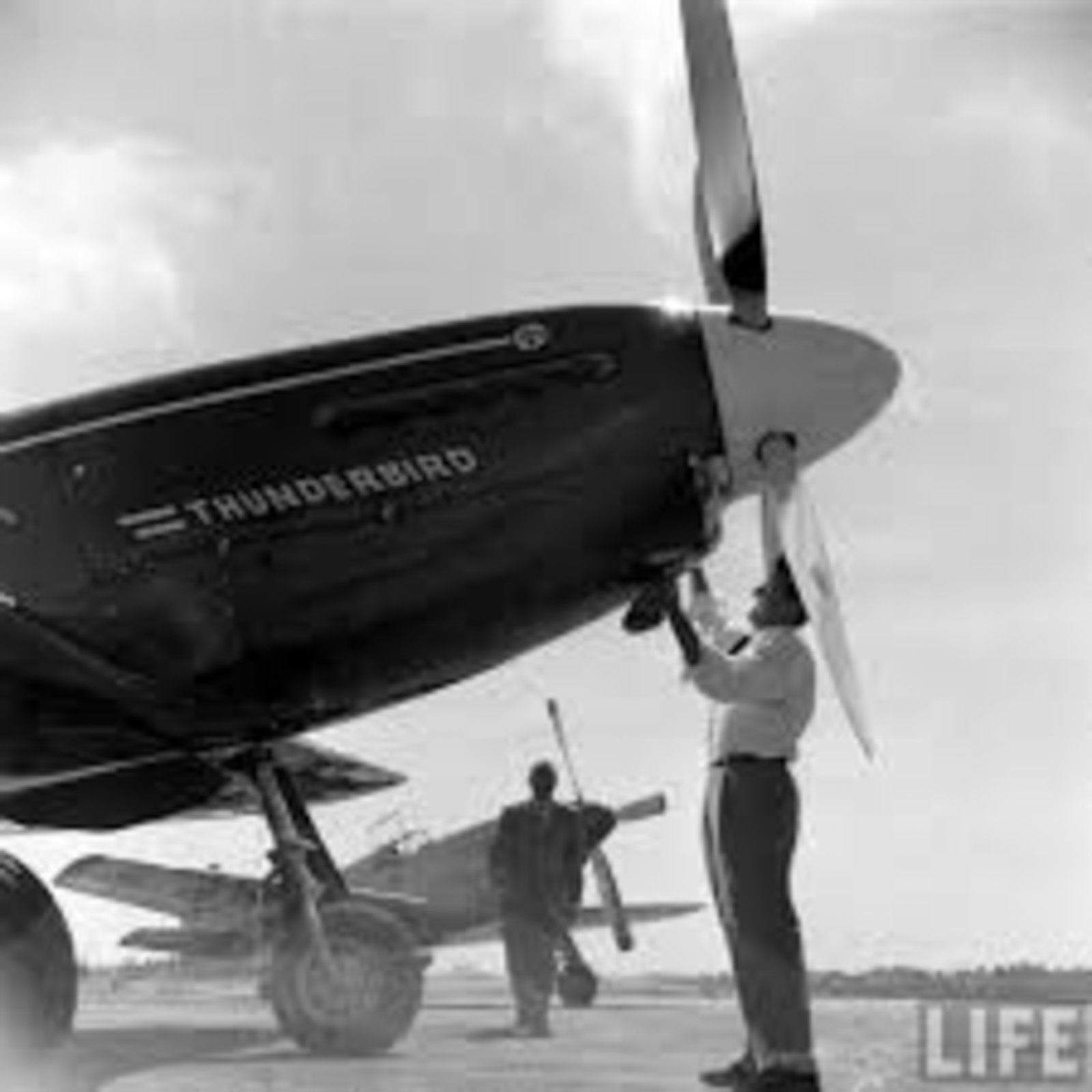
In successive updates, we will examine Thunderbird’s history after Jackie Cochran acquired her. We will also detail other fascinating aspects of this project, from the records set, to the many contributions from supporters in the aviation, warbird, and air racing communities.
The project is the culmination of Warren Pietsch’s dream. As already noted, he has long been fascinated by Thunderbird’s history. This dream involved creating a P-51C which represents Thunderbird’s unique history, and recognizes the many people who have influenced and helped Warren, in addition to highlighting the rich story of Thunderbird’s celebrity owners and record-setting flights.
Thunderbird isn’t intended to be a rivet-by-rivet restoration, but rather a “time capsule” restoration capturing a period in Mustang lore not currently represented by airworthy P-51s. The most important goal is to make this flying piece of aviation history a people’s airplane that everyone’s enjoyment – from Mustang and air racing enthusiasts, to air show attendees.
There is a great deal more historical information to relate, which we will unveil in the next update. Besides Jimmy Stewart and Joe DeBona, household names in aviation and popular culture such as Jackie Cochran, and even Queen Elizabeth II are part of Thunderbird’s unique story.
Warren Pietsch became involved in bringing Thunderbird back to life in 1999. Now two decades later, after years of gradual work taking place, Thunderbird arrived at AirCorps Aviation as a fuselage, empennage and a set of wings. The airframe was largely complete, structurally speaking, but still required systems and firewall forward installation, wiring, final paint and finish work. AirCorps will complete these remaining tasks to their usual, world-class standards. Thanks to the parts which Warren has collected over the past 15 years, the timeline to complete Thunderbird will be much shorter than a typical warbird restoration.
One of the real challenges in this restoration is determining the precise paint colors used in 1949, and duplicating all of the aircraft’s smaller exterior markings. While there are photographs from Thunderbird’s heyday, color photographs are not always an accurate match to original paint colors. Additionally, not every airframe aspect is visible in the photos we have, which makes it difficult to accurately verify marking placement and decals. Any help locating additional photographs would be very much appreciated.
Wing Modifications
Mustang enthusiasts will notice that the wing and some of the lower engine cowling chosen for this project come from a P-51D and don’t match the C-model fuselage. Ultimately, it was Warren’s choice to use the D-model wing, and this meant changing the lower cowl from the three-piece B/C model to the one piece D-model skin, due to the increased cant of that variant’s wing. The landing light position also moved from the wing leading edge to a location inside the landing gear well to produce less drag with the gear retracted.
One of the aspects affecting this choice to use a D-model wing relates to both safety and handling qualities. The later model wing has more robust and reliable landing gear and gear door systems. The B/C wing’s clamshell doors were lighter and had a single uplock, while the D gear doors have multiple locks which make cycling the gear more reliable. Additionally, there are documented instances of B/C doors tearing off in high speed dives, so North American re-engineered an updated system for the D model.
Interestingly, the early model clamshell doors on the original Thunderbird may have been what caused the aircraft to crash in June of 1955 when they closed out of sequence, jamming the main landing gear. The owner at the time, Joe Cook, elected to bail out rather than risk a landing in the wet-winged Mustang with the gear now protruding from the airframe.
In addition to improved gear doors, the D model wing also has stronger and more effective ailerons. A seal added to the aileron leading edges reduced stick pressure during hard maneuvering.
With all of the technical considerations and improvements which the D wing includes, electing to use this later style on Thunderbird made sense on paper. However, Warren already has extensive, real-world experience flying many different C and D model P-51s. He selected the D-model wing because he prefers the flying characteristics of that variant.
Fortunately, North American Aviation pioneered fitting a D wing on a B/C Mustang during the war. It was an idea the company built and tested, but never produced. The documentary existence of this factory-tested prototype made obtaining FAA approval for these major alterations far easier.
Lower Fuselage
One of the areas which requires a lot of time in a Mustang restoration is the lower fuselage which comprises the air scoop, doghouse, radiator wrapper, and exit duct. These components house the radiator, oil cooler and exit door. Luckily, with Thunderbird, we had original parts for several of these major elements which required only minor restoration before we could fit them to the airframe.
Wing Fillets
Randy Carlson of Carlson Metal Shaping has done outstanding work assisting us with wing fairings and complex metal shapes. He is a specialist in the complexity of forming these tightly compound-curved pieces. This month, we will highlight his work on the wing fillets which blend the wings into the fuselage for a decrease in interference drag.
Parts
Organizing parts so restorers can easily find them and have everything they need for a particular assembly speeds the restoration process dramatically.
And that’s all for this exciting news about the resurrection of Thunderbird. We will present further updates as this famous racing aircraft returns to her former glory. Many thanks to Chuck Cravens and everyone at AirCorps Aviation and the Dakota Territory Air Museum for their help in making this article possible.








